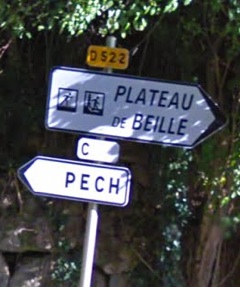 The past 48 hours have been a painfully ironic reminder of why I think this sort of comparison is silly. Forget weather, race situation, GC consideration and day-of tactics—unsourced historical records, ambiguous starts and finishes, and conflicting reports are enough hassle on their own.
The past 48 hours have been a painfully ironic reminder of why I think this sort of comparison is silly. Forget weather, race situation, GC consideration and day-of tactics—unsourced historical records, ambiguous starts and finishes, and conflicting reports are enough hassle on their own.
But with decent footage of every ascent to Plateau de Beille, including two by a yellow-clad Tommy Voeckler, and with the second big mountain-top finish of the year bringing another unexpected result, the opening to take an incisive look at the times is just too tempting.
The “start” at Plateau de Beille is kind of a hard thing to nail down. While the finishes on each of the videos I used looked the same, the heads-up KM-to-go displays varied pretty widely. Even Phil and Paul were inconsistent between years, citing both a sharp left-hand bend in the town of Les Cabannes and a 16km to go KOM banner as official climb starts—of course, as Ted King will tell you, trust the roadside banners at your own peril.
There also seems to be some dispute about the length of the thing. VS coverage seemed to suggest 15k, Strava says 15.2km, The Sport Scientists say 15.8km, and honestly, with the switchbacks, they all might be right. Considering how much climbing there seems to be within Les Cabannes itself—and the fact that there are hundreds of kilometers of racing beforehand—the ambiguity is understandable.
But if we want to maintain some semblance of precision in all this, we have to draw a line somewhere. If were Emperor of Bike Racing, I would declare this intersection the start, since it seems to mark a transition between village roads an unmistakeable, Euro-style climbing. But alas, that quaint sign is almost impossible to pick out behind the fans, on video filmed from the back of a motorbike, and this prominent 150m sign next to a caravans advertisement a few hundred meters earlier will have to suffice. Screenshots for the incredulous:
You’ll note that there are only four years represented here. Unfortunately, I can’t find uncut video of Pantani’s apparently record-setting ascent from 1998. It’s a great watch if you do get the chance, with Ullrich sprinting back on au bloc after a puncture in Les Cabannes, before Pantani storms away in the drops, but the performance would have required some correction factor anyway, since the ’98 course is reported to have finished at a lower elevation than later ascents.
Because I set my own line for the start, I also had to pin down my own elevation and length numbers. Ideally, I’d be able to head out there and ride it on a sunny day with a barometric altimeter, holding a path roughly equidistant between the center line and shoulder. Sadly, that’s not an option for me, so I’ll have to trust that Strava user Alex Palmer didn’t do too much Paper Boy on his way up. Here’s the “official” segment I’ll be using, from the aforementioned sign to the final curve of the ski-area turnaround: 15.6km, 1214m, 7.8%.
So, numbers-wise, what does that give us? Here are the PdB Stage Winner and “Tommy Voeckler group” (he finished alone in ’04) figures, ordered fastest-to-slowest, measured against the best performance (excluding Pantani for reasons noted above):
Time Back
| VAM
| %Diff VAM
| Inferred W/Kg | | |
Winner 2007
| 0:00:00
| 1,654
| 0
| 5.95 | |
Winner 2004
| 0:01:20
| 1,605
| -2.94
| 5.77 | |
Winner 2002
| 0:01:44
| 1,591
| -3.79
| 5.72 | |
Winner 2011
| 0:02:05
| 1,579
| -4.52
| 5.68 | |
Voeckler 2011
| 0:02:52
| 1,553
| -6.11
| 5.58 | |
Voeckler 2004
| 0:06:02
| 1,454
| -12.05
| 5.23 | |
The first thing I notice is that, compared to Luz Ardiden, the difference between this year’s times and historical performances isn’t nearly as sharp, especially if you’re looking at Armstrong (’02, ’04). Of course, considering the GC situation in ’03, its no stretch to imagine that the ’03 Luz climb represented a removal of all the stops, both in terms of tactics and in terms of biochemical enhancement. Still, while the gaps weren’t as large, a significant, across-the-board decline for the 2011 numbers remained.
The second thing that catches my eye is Voeckler’s improvement between 2004 and last Saturday (he did race PdB in ’07, but having no GC position to consider, finished 42 minutes down in the autobus). I’d noted that on Thursday, the winner was as far behind Armstrong’s time as Voeckler used to be, but now that we’ve got some direct comparisons, you can see that his presence at the head of affairs isn’t merely the top end of the field slowing down.
There’s always the spectre of doping, I guess, but one likes to think that a rider who revels in his aggressive, opportunistic style wouldn’t feel compelled to dose up in pursuit of a title he doesn’t think he can win. Voeckler is slimmer—he’s lost some of the round-faced, cherubic appeal he had in 2004, he won a very hilly “classic” last fall, and was a presence on the bergs this spring. He’s also got team support, something Brioche la Boulangere just couldn’t offer. In ’04, Voeckler had also been dropped at least once before even arriving the foot of Plateau de Beille, suggesting he might have been having a rougher day—or suffering from a more intense pace.
Which brings me to one last note—the speeds leading up to the foot of Plateau de Beille on Saturday were uncharacteristically slow, and the peloton experienced minimal breakup over the previous climbs. That’s a pretty sharp contrast to 2004, when a group of just 22 (including 7 Posties) crested the penultimate climb, or to 2007, when Contador brought home the 200km, 3-climb stage in 22.5 mph. That’s all the more noteworthy when you consider that Saturday’s stage was over 30km shorter than the previous two ascents.
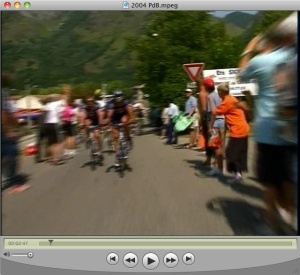
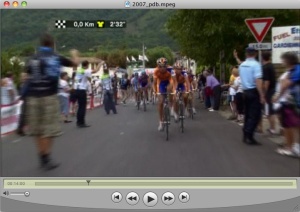
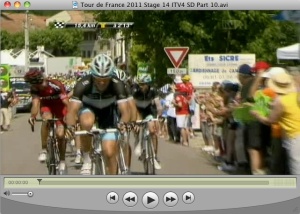
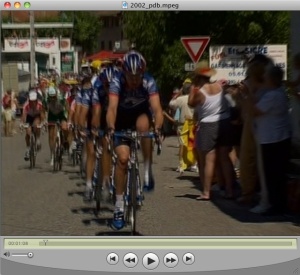

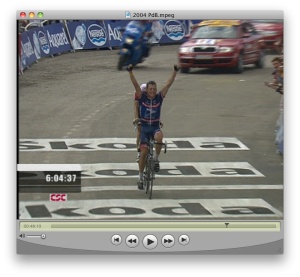
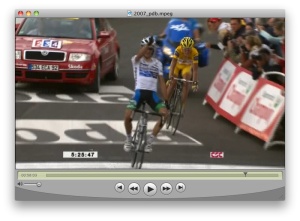
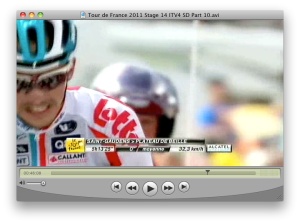
Another interesting analysis. It’s true that TV’s climbing does seem to have bumped up a notch this year. Even this spring he was often able to finish with a select group of 5 to 10 riders who reached the top of a climb together. Once that core group starts splintering, he gets into trouble, but until that point he seems more than able to keep pace. (Indeed, in the TDF he’s been able to ride at the front and mark attacks rather than just cling to the back.)
Anyway, this is going to be a helluva last week. When was the last time a TDF had at least five guys still in the hunt with a week to go?
!
Only thing is that that yield sign was moved back in 09 as part of a wetlands reclamation project
Just realized I left off the overall times I recorded for the climb. In reverse chronological order:
Vanendert, 2011 – 0:46:08
Voeckler, 2011 – 0:46:55
Contador, 2007 – 0:44:03
Armstrong, 2004 – 0:45:23
Voeckler, 2004 – 0:50:05
Armstrong, 2002 – 0:45:47
Remarkable that Contador and Rasmussen climbed faster than Armstrong and Basso in ’04. Armstrong was in top form that year, and there was no real attacking to speak of–the Posties just rode at massive pace all the way uphill and dropped everyone. I would have thought the climb would have been clocked at much faster.
Years from now it would be interesting to hear accounts of a “game within a game,” the continual changing of, er, non-publicized training techniques to adapt to changes in rules and testing. The ability to adapt seems to be a huge part of winning, and in itself suggests just what a good job certain teams were doing in that era.
excellent, enjoyed tis very much.
Their VAM shames me (nah, I am ok) – but impressive
The 2004 stage was an extra cat 3 climb and 40 km longer than 2011 (each had two 1’s, two 2’s, and a 3, but 2004 had an extra 3) yet run 1.6 kph faster, while 2007 stage was much different, preceded by an early cat 2 and a HC climb. Context is always important.
A little Tommy just put time into Schlecks on stage 16.
I’m not sure if Tommy dopes or not, I’m on the fence, I like his pithy comments on other people doping, I like his racing (though he is clearly out only for himself) and I think if any teams are clean it’s the French teams.
What I do know, the Schlecks are as big of a bunch of B!tches as Contador.
“the ‘03 Luz climb represented a removal of all the stops”
Just to nitpick, the expression is to “pull out all the stops”. This comes from the pipe organ. On a pipe organ each stop controls a set of pipes. When you pull out a stop, you enable that set of pipes. When you pull out all the stops the organ makes as much sound as possible. It doesn’t make any sense to “remove” the stops.
Nice post, Cosmo. i’m going to have to stop reading the comments on your posts. At one time there were interesting disussions that you included yourself in. Now it’s mostly didactic drivel.
Thanks, Cosmo. I have always enjoyed watching Voeckler, and this year I just can’t shake the feeling he’s doping. I know he’s had an amazing year prior to the TdF and that just makes it more plausable. I mean so many, so suddenly? And he looks so different. This numbers are are making that little nagging feeling seem more plausable. I hope I am wrong.
Voekler rode brilliantly up PdB. Check Contador’s 2007 time… Maybe some tainted steak floating around that year too?
I’m trying to make sense of L’Alpe d’Huez times…
This source has times “from the foot of the climb to the finish” : https://twitpic.com/5u6vcz
Science of Sport has 24 seconds quicker for both Contador and Sanchez, from the “start of the climb to the finish”: https://www.sportsscientists.com/2011/07/tour-2011-alp-dhuez-leaving-mountains.html
Wikipedia has 21 seconds faster for Rolland (who wasn’t even fastest on the day, by most other reports): https://en.wikipedia.org/wiki/Alpe_d'Huez
The Wikipedia page says there is a camera for “official timing” 14.0 km from the finish, but that the traditional starting point for the climb is 200 meters later (with a marker of some sort) which would explain the time difference.
Cosmo: You mention Voeckler is slimmer now than he was in 2004, implying he must be also lighter, explaining his improved climbing abilities. The August issue of Cycle Sport has an excellent pre-Tour interview with Voeckler in which he says he actually weighs six kilos more than he did in 2004, giving him greater strength to ‘”hold off the peloton over the last two or three kilometres of a race–I wouldn’t have been able to do that in the past.” You are right though about his losing his chubby cherubic look, as he says he has reduced his body fat from ten to six per cent. “I’ve even had to change clothes size,’ he says.
What an awesome way to explain this-now I know eevryihtng!
Heya Cyclocosm, missing your “how the race was won” video series on tube! Planning a comeback?
Cycling which is loaded with an awful lot of
ambitions and passions is popular with people of all ages. The reason why cycling competition
could draw a large spectators is that it is the kind of game that will always create chances and miracles.
It is something brimming with the youth breath. permeated with the beauty of youth..It approaches us with a
brightful color and raises our heart rate.And we are caught up in this kind competition, in which the competitor
dressed up there with the cycling clothing,
cycling arm warmers,
and cycling gloves which are sponsored by the riding team.
And tour de france is the sacred ground in every competitiors’heart.It means not only the NO.1 but also the splendid
dream and a flush of their life. Every year’s competiion comes with a blast of mysteries,because of a lot of unknowns that which team will become the winners, Astana. Bmc, cannondale, castelli, discovery channel or garmin?And movistar , multivan merida , scott, sky, specialized, trek are also the impossible ones.It seems to be full of endless energy and
passion,and the sky is the limit.
Cosmo, FFS. Surely you won’t sit silent while we all suffer the indignity of the sham that was the result on Angliru, particularly when it puts the likes of Wiggins out of red. I can’t decide what is more depressing – the nonsense that was Cobo’s performance (faster than Heras in 2002), or the fact that UCI politics will dictate whether a positive control is reported, not the actual result of the control.
Cycling has gotten increasing popularity, the importance of
suitable cycling clothing has become clearly. A quality pro cycling jersey for cycling is critical for casual and regular riders.
Hello? Hello? Cosmo?